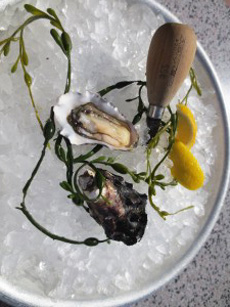

Totten Island oysters. Photo courtesy Waterbar | San Francisco.
July 2007
Last Updated April 2013
|
 |
Fresh Oysters
Oyster Glossary
Part 8: Oyster Types Beginning With S To Z
CAPSULE REPORT: This is page eight of a nine-page article about fresh oysters and related foods. Here, oyster types beginning with S to Z. Click on the black links below to visit other pages. Also visit our many other food glossaries that focus on other favorite foods, including a 13-page Seafood Glossary.
SALUTATION COVE OYSTER
A Virginica oyster, farm raised on Prince Edward Island. The oyster has a very deep, attractive cup and are very delicate in texture, salty with a sweet, crisp finish. It is available year-round.
SAMISH BAY OYSTER
A variety of Pacific oyster with plump meat and an assertive flavor.
SHOALWATER OYSTER
An oyster harvested in Willapa Bay, a large inlet of salt water located on the southwest Pacific coast of Washington State. Shoalwater Bay is the former name of Willapa Bay.
SHOOTERS or OYSTER SHOOTERS
Raw oyster meats mixed with vodka and seasonings (hot sauce, lemon juice) and consumed in a shot glass. Here‘s a more refined oyster shooters recipe from James Beard House.
STEAMBOAT or SUNSET BEACH OYSTER
A Pacific oyster from the pristine southern Puget Sound of Washington State. Steamboat Island is a small island located north of Olympia that is a prime oyster growing region. It is a meaty oyster that is great to cook with because it is able to maintain its signature melon taste even when fried, grilled or baked. Typically 3-1/2 to 4 inches in size. |
|

Oyster shooters. Photo by Stephanie Bourgeois | James Beard House. |
SUMMER OYSTER
An oyster available in the warmer months, e.g., from May to November. Other varieties are available year-round.
SYDNEY ROCKOYSTER
The oyster species endemic to Australia and New Zealand. The species is Saccostrea glomerata, formerly known as Saccostrea commercialis.
TATAMAGOUCHE “or TATE” OYSTER
A wild oyster considered to be one of the finest Nova Scotia oysters. Tatamagouche doesn’t get much beyond Nova Scotia as it is in limited supply. Tatamagouche Bay is located on the northern shore of Nova Scotia, where the neck of land connects Nova Scotia with the mainland. The oyster is quite salty and mildly sweet, with the clean crisp finish of a good eastern oyster. It is available year-round.
TERROIR
Pronounced tuhr-WAH, a term borrowed from the French expression for sense of place, the environment in which something grows. The flavor of the agricultural product will reflect the unique climate and soils of its terroir. Each location where oysters grow has a unique water composition and other factors impacting the environment that impart flavors to the oysters—more limestone and minerality versus more kelp and seaweed, for example. Some waters are pristine and nutrient-rich, some waters are less so. |
|

An oyster’s flavor nuances reflect the terroir of the water in which it was grown. Photo courtesy Louisiana Seafood News. |
TOMALES BAY OYSTER
From Tomales Bay, north of San Francisco, where the Olympic oyster (Ostrea lurida) was native before before intensive harvesting during the Gold Rush of 1849 pushed it to the edge of extinction. Twenty years ago, local ranchers replanted with the Pacific oyster. The Tomales Bay Oyster has a good texture and crisp briny flavor.
TOTTEN INLET OYSTER
A Virginica oyster farmed in Puget Sound, Washington. The meat is plump and firm and the flavor is very sweet with a mild, fruity finish. See photo at top of page.
VIRGINIA OYSTER
See Virginica oyster, below.
VIRGINICA OYSTER
Crassostrea virginica, Also called the Eastern, East Coast or Atlantic oyster, is native to the Atlantic coast of the Americas, from Nova Scotia to South America. Varieties include Beausoleil, Blue Point, Chesapeake Bay, Chincoteague, Lynnhaven, Malpeque, Pemaquid, Pine Island, Pugwash and Wellfleet. Virginica varieties tend to have more saltiness than the Pacific oysters; the meat is described as clean, briny, smooth and sweet with a pronounced mineral finish. Virginicas are generally crisper and brighter than Pacific oysters, with a clean brininess and minerality. In contrast to the Pacific oyster, Virginicas have a tear drop shape, smooth shell, and uniform color, which can be brown, cream, or forest green. Their growth is particularly affected by water temperature, as an oyster from Virginia may reach market size in eighteen months while a Nova Scotian oyster may take four years. |
|

Virginica oysters Mill Cove, Maine. Photo courtesy Waterbar | San Francisco. |
| |
 |
| |
From left to right: Pacific, Virginica and Kumamoto oysters. Photo by Hugo Chang | IST. |
WELLFLEET OYSTER
A variety of Virginica oyster from the salt marshes of Wellfleet, on Cape Cod in Massachusetts. Salt marshes, which are fed by springs, are a perfect environment for raising oysters. The oyster is slightly salty with a crisp flavor and mild finish.
YAQUINA BAY OYSTER
A Pacific oyster harvested in Yaquina Bay, a small bay partially within Newport, Oregon, where the Yaquina River flows into the Pacific Ocean.
Continue To Page 9: Types Of Oysters Beginning With S
Go To The Article Index Above

|








